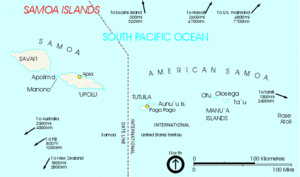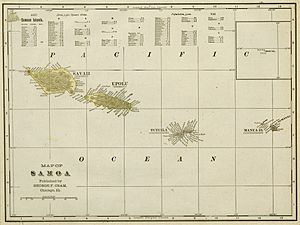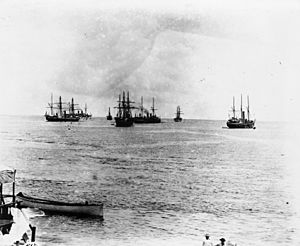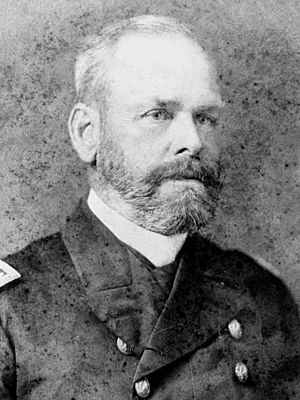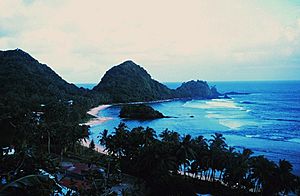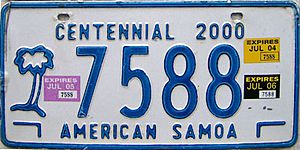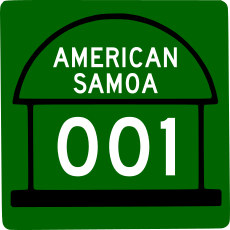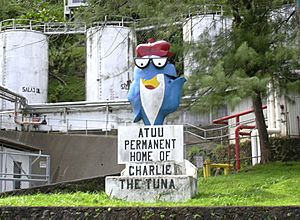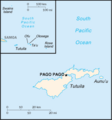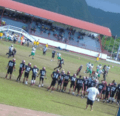American Samoa facts for kids
Quick facts for kids
American Samoa
Amerika Sāmoa
|
|||
|---|---|---|---|
|
|||
| Motto(s):
"Sāmoa, Muamua Le Atua" (Samoan) (English: "Samoa, Let God Be First")
|
|||
| Anthem: "Amerika Samoa" |
|||

Location of American Samoa
(circled in red) |
|||
| Sovereign state | |||
| Partition of Samoa | December 2, 1899 | ||
| Ratification Act | February 20, 1929 | ||
| Capital | Pago Pago | ||
| Government seat | Fagatogo | ||
| Largest village | Tāfuna | ||
| Official languages |
|
||
| Ethnic groups | |||
| Religion |
|
||
| Demonym(s) |
|
||
| Government | Devolved presidential constitutional dependency | ||
| Joe Biden (D) | |||
|
• Governor
|
Lemanu Peleti Mauga (D) | ||
|
• Lt. Governor
|
Salo Ale (D) | ||
| Legislature | Fono | ||
| Senate | |||
| House of Representatives | |||
| Area | |||
|
• Total
|
77 sq mi (200 km2) | ||
| Highest elevation | 970 m (3,170 ft) | ||
| Population | |||
|
• 2021 estimate
|
46,366 (210th) | ||
|
• Density
|
670.8/sq mi (259.0/km2) | ||
| GDP (PPP) | 2016 estimate | ||
|
• Total
|
$658 million | ||
|
• Per capita
|
$11,200 | ||
| Currency | United States dollar (US$) (USD) | ||
| Time zone | UTC−11:00 (SST) | ||
| Date format | mm/dd/yyyy | ||
| Driving side | right | ||
| Calling code | +1-684 | ||
| USPS abbreviation |
AS
|
||
| ISO 3166 code |
|
||
| Internet TLD | .as | ||
American Samoa ( [Amerika Sāmoa also Amelika Sāmoa or Sāmoa Amelika] Error: {{Lang-xx}}: text has italic markup (help)) is a special territory of the United States. It is located in the South Pacific Ocean, southeast of the country of Samoa.
American Samoa is made up of five main islands and two coral atolls. An atoll is a ring-shaped island made of coral. The largest and most populated island is Tutuila. Other islands and atolls in the territory are the Manuʻa Islands, Rose Atoll, and Swains Island.
The U.S. 2020 census showed that about 49,710 people live here. The total land area is about 77 square miles (199 square kilometers). This is a bit larger than Washington, D.C.. American Samoa is the southernmost territory of the U.S. It is one of two U.S. territories south of the Equator. The other territory south of the Equator is the uninhabited (nobody lives there) Jarvis Island. Tuna products are the main things American Samoa sells to other countries. Its main trading partner is the United States.
During the 1918 flu pandemic (a worldwide sickness), Governor John Martin Poyer made sure no one entered or left the territory. This is called a quarantine. Because of his quick action, American Samoa was one of the few places in the world where no one died from the flu.
American Samoa has the highest rate of people joining the military (military enlistment) compared to any U.S. state or territory. In 2014, the local U.S. Army Recruiting Station in Pago Pago signed up the most soldiers. This was out of 885 Army recruiting stations across many places, including all 50 U.S. states.
Most American Samoans can speak two languages (they are bilingual). They speak English and Samoan very well. Samoan is the same language spoken in the nearby independent country of Samoa.
Contents
- Exploring the History of American Samoa
- Important Events in American Samoa
- Geography of American Samoa
- Climate in American Samoa
- Getting Around American Samoa
- People and Culture of American Samoa
- Culture and Sports in American Samoa
- Economy of American Samoa
- Fun Facts About American Samoa
- Images for kids
- See also
Exploring the History of American Samoa
First European Visitors in the 1700s
Europeans first came to the Samoan Islands in the early 1700s. A Dutch explorer named Jacob Roggeveen was the first European to see the islands in 1722. Later, in 1768, a French explorer named Louis-Antoine de Bougainville called them the Navigator Islands. Not many Europeans visited until the 1830s, when English missionaries and traders started to arrive.
In the 1700s, a battle happened between French explorers and islanders on Tutuila. This place is now called Massacre Bay. People in the West blamed the Samoans for this fight. This made others believe that the native people were fierce.
The 1800s: Missionaries and Ships
Missionaries began their work in Samoa in late 1830. John Williams of the London Missionary Society arrived from the Cook Islands and Tahiti. By this time, Samoans were known for being strong and warlike due to past fights with European visitors. However, by the late 1800s, ships from French, British, German, and American navies often stopped in Samoa. Pago Pago Harbor was a good place for coal-powered ships and whaling boats to refuel.
In March 1889, a German naval force entered a village on Samoa. They destroyed some American property. Three American warships then went into Apia Harbor, ready to fight the three German warships there. But before any shots were fired, a typhoon (a very strong storm) destroyed both the American and German ships. Since there were no ships left to fight, the two countries had to agree to stop fighting (an armistice).
Early 1900s: Dividing the Islands
The Tripartite Convention of 1899 solved the disagreements between three countries over the Samoan Islands:
- Britain gave up its claims to Samoa. In return, it gained control over certain areas in Tonga, the Solomon Islands, and West Africa.
- The United States and Germany agreed to divide the Samoan Islands into two parts:
- 1. The eastern islands became a territory of the United States. This included the Tutuila Islands in 1900 and Manuʻa in 1904. Today, this is known as American Samoa.
- 2. The western islands, which were much larger, became known as German Samoa.
American Samoa Becomes a U.S. Territory
The next year, the U.S. Navy officially took control of eastern Samoa for the United States government. The existing coaling station (a place to get coal for ships) at Pago Pago Bay became a full naval station. It was called the United States Naval Station Tutuila.
On July 17, 1911, the U.S. Naval Station Tutuila was officially renamed American Samoa. This included Tutuila, Aunuʻu, and the Manuʻa Island group (Ofu and Olosega - joined by a bridge - and Taʻu).
World War I and the 1918 Flu
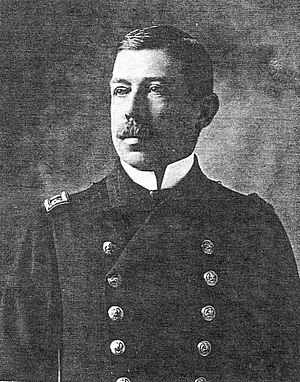
In 1918, during the end of World War I, the flu pandemic was spreading fast around the world. American Samoa became one of only three places that stopped any deaths from the flu. This was thanks to the quick actions of Governor John Martin Poyer. He heard about the outbreak on the radio and asked for quarantine ships from the U.S. mainland. These ships helped keep the disease from spreading to American Samoa.
Governor Poyer received the Navy Cross for his quick thinking. American Samoans saw him as a hero for saving them from the deadly disease. The nearby New Zealand territory, Western Samoa (which used to be German Samoa), suffered greatly. 90% of its people got sick, and many died. Poyer offered to help Western Samoa, but their administrator, Robert Logan, refused. Logan was angry about the quarantine ships around American Samoa and stopped talking to them.
Between the World Wars
The American Samoa Mau Movement
After World War I, there was a movement for independence in Western Samoa called the Mau movement. A similar movement started in American Samoa, led by Samuelu Ripley. He was a World War I veteran from Leone, Tutuila. After meetings in the United States, he was not allowed to return home. The U.S. Navy stopped the American Samoa Mau movement. In 1930, the U.S. Congress sent a group to look into American Samoa's situation.
Adding Swains Island
Swains Island was added to American Samoa in 1925. This island had been listed under the Guano Islands Act, which allowed the U.S. to claim islands with bird droppings (guano) used for fertilizer.
First Trans-South Pacific Flight
In 1938, the famous aviator Ed Musick and his crew died near Pago Pago. Their plane, the Samoan Clipper, exploded during a flight to Auckland, New Zealand. The plane had problems after takeoff, and Musick turned back. While the crew was dumping fuel to prepare for an emergency landing, the explosion happened.
World War II and After
During World War II, more U.S. Marines were stationed in Samoa than people who lived there. The marines had a big impact on the local culture. Young Samoan men aged 14 and older were trained for combat by U.S. military staff. Samoans helped in many ways during World War II, including as soldiers, medical helpers, code workers, and ship repairers.
In 1949, a U.S. Department of Interior plan tried to make American Samoa a full part of the U.S. The Samoans did not want this. Samoan chiefs, led by Tuiasosopo Mariota, helped stop the plan. Their efforts led to the creation of a local government body called the American Samoa Fono. This group meets in the village of Fagatogo.
From 1951 to 1999
By 1956, Peter Tali Coleman, who was chosen by local elections, became governor. He replaced the U.S. Navy-appointed governor. American Samoa now governs itself under its own constitution, which started on July 1, 1967. The U.S. Territory of American Samoa is on the United Nations list of Non-Self-Governing Territories. However, the local government officials do not agree with being on this list.

American Samoa and Pago Pago International Airport were important for the Apollo Program. This was the U.S. space program that sent astronauts to the Moon. The astronaut crews of Apollo 10, 12, 13, 14, and 17 were picked up near Pago Pago. They were flown by helicopter to the airport before flying to Honolulu on military planes.
American Samoa and Western Samoa share a language and ethnicity. However, their cultures have grown differently. Many American Samoans have moved to Hawaii and the U.S. mainland. They have adopted U.S. customs, like playing American football and baseball. Western Samoans have tended to move to New Zealand. This has made sports like rugby and cricket more popular in the western islands.
The 21st Century
Because of money problems, joining the military has become a good opportunity in American Samoa. Many American Samoans have joined the military. This means a higher percentage of American Samoans have died in wars compared to U.S. citizens. As of 2009, ten American Samoans had died in Iraq, and two died in Afghanistan.
Important Events in American Samoa
Events Before the 1900s
On December 10, 1787, French sailor Jean-François de Galaup, comte de Lapérouse sent two groups of explorers to Tutuila's north shore. The next day, on December 11, 1787, twelve of his crew members were killed by angry Samoans at A'asu Bay, Tutuila. From then on, A'asu Bay has been called "Massacre Bay." This event made people think Samoans were savage. It kept Europeans away for forty years until the first Christian missionaries arrived.
On March 25, 1891, the famous writer Robert Louis Stevenson made a rare visit to Pago Pago.
Events in the 1900s
Famous Visitors
Several famous people have visited American Samoa:
- On December 15, 1916, English writer William Somerset Maugham arrived in Pago Pago. His visit inspired him to write the short story "Rain."
- On August 11, 1925, Margaret Mead came to American Samoa. She started her research for her advanced degree in anthropology (the study of people and cultures).
- On August 24, 1943, First Lady Eleanor Roosevelt visited American Samoa. She inspected the Fita Fita Guard and Band and the First Samoan Battalion of the U.S. Marine Corps Reserve.
- On October 18, 1966, President Lyndon Baines Johnson and First Lady Lady Bird Johnson visited American Samoa. The territory's only hospital was renamed in honor of President Johnson. Mrs. Johnson also opened an elementary school named after her.
- In November 1970, Pope Paul VI visited American Samoa for a short but grand welcome.
Key Events
On January 11, 1942, a Japanese submarine fired about 15 shells at the U.S. Naval Station Tutuila. This was the only time the Japanese attacked Tutuila during World War II. The shells caused little damage.
In the late 1960s and early 1970s, American Samoa played a role in five of the Apollo Program missions. Astronauts landed near Pago Pago and were brought to the islands on their way back to the mainland. President Richard Nixon gave three moon rocks to the American Samoan government. These are now on display in the Jean P. Haydon Museum, along with a flag that went to the moon.
On January 30, 1974, Pan Am Flight 806 crashed at Pago Pago International Airport. 86 people died, including the entire flight crew.
On April 17, 1980, a U.S. Navy plane crashed after hitting a tramway cable across Pago Pago Harbor. The plane was carrying six skydivers who had already jumped and were safe. However, the crash destroyed part of a hotel and killed all six crew members and one civilian. A monument honors their memory.
Events in the 21st Century
On July 22, 2010, Det. Lt. Lusila Brown was shot and killed. This was the first time since 1998 that a police officer was killed while on duty.
On November 7, 2010, United States Secretary of State Hillary Clinton stopped at Pago Pago International Airport for fuel. She was greeted by local leaders and received gifts. She also took part in a traditional 'ava ceremony, where a special drink is shared for important occasions.
September 2009 Earthquake and Tsunami
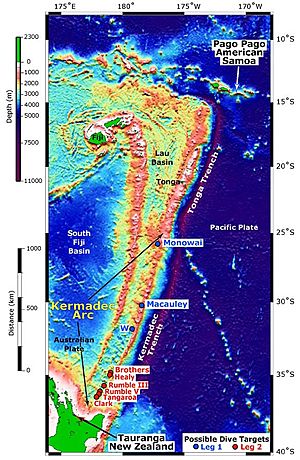
On September 29, 2009, a very strong 8.1 magnitude earthquake struck about 120 miles (193 kilometers) off the coast of American Samoa. This was the largest earthquake of 2009. The quake happened in an area called the Pacific Ring of Fire. This is where Earth's tectonic plates meet, and earthquakes and volcanoes are common.
The earthquake caused a tsunami (giant ocean waves) that killed over 170 people in the Samoa Islands and Tonga. Four waves, 15 to 20 feet (4.5 to 6 meters) high, traveled up to one mile (1.6 kilometers) inland on the island of Tutuila. The Defense Logistics Agency (DLA) and the Federal Emergency Management Agency (FEMA) provided tents to help the damaged areas of American Samoa.
Geography of American Samoa

American Samoa is located in Oceania. It is one of only two U.S. possessions in the Southern Hemisphere. The other is Jarvis Island. Its total land area is about 76 square miles (197 square kilometers). This is a bit larger than Washington, D.C.. It includes five rugged, volcanic islands and two coral atolls. The five volcanic islands are Tutuila, Aunuʻu, Ofu, Olosega, and Tau. The coral atolls are Swains Island and Rose Atoll. Of the seven islands, Rose Atoll is the only uninhabited one. It is a Marine National Monument, which means it is protected.
Because it is in the South Pacific Ocean, American Samoa is often hit by tropical cyclones (strong storms) between November and April. Rose Atoll is the easternmost point of the territory. American Samoa is the southernmost part of the United States. The National Park of American Samoa is also located here.
Vailulu'u Seamount: An Underwater Volcano
The Vailuluʻu Seamount is an active underwater volcano. It lies 28 miles (45 kilometers) east of Taʻu in American Samoa. Scientists discovered it in 1975 and have been studying it since. These studies help them understand how the Earth works. Inside the top crater of Va'ilulu'u, there is an active underwater volcanic cone. It is named after Samoa's goddess of war, Nafanua.
Climate in American Samoa
American Samoa has a tropical climate all year round. The average daily temperature is about 81˚- 83˚ Fahrenheit (around 28° Celsius). It has two main seasons: the wet season and the dry season. The wet season is usually from December to March. The dry season is from April through November.
Getting Around American Samoa
American Samoa has about 150 miles (241 kilometers) of highways. The fastest speed limit is 30 miles per hour. Ports and harbors include Aunuʻu, Auasi, Faleāsao, Ofu, and Pago Pago. American Samoa does not have any railways. The territory has three airports, all with paved runways. The main airport is Pago Pago International Airport.
People and Culture of American Samoa
Population and Languages
| Historical population | ||
|---|---|---|
| Year | Pop. | ±% |
| 1960 | 19,000 | — |
| 1970 | 27,159 | +42.9% |
| 1980 | 32,297 | +18.9% |
| 1990 | 46,773 | +44.8% |
| 2000 | 57,291 | +22.5% |
| 2010 | 55,519 | −3.1% |
| 2016 | 54,194 | −2.4% |
As of 2021, American Samoa has about 54,390 people. 97% of them live on the largest island, Tutuila. About 65% of the people are U.S. nationals, and at least 10% are U.S. citizens. Of the people born outside American Samoa, 81% are from Samoa.
American Samoa is small enough to have just one ZIP code, 96799. It uses the U.S. Postal Service for mail delivery.
91.6% of the people in American Samoa are native Samoans. Most people can speak two languages. Samoan is spoken by 91% of the people. It is similar to Hawaiian and other Polynesian languages. Samoan and English are the official languages of the territory. 80% of the people speak English.
Religion
Most people on the island are Christian. Major Christian groups include the Congregational Christian Church in American Samoa, the Roman Catholic Church, and The Church of Jesus Christ of Latter-day Saints. Other groups include Seventh-day Adventists, Pentecostals, and Methodists.
The Congregational Christian Church in American Samoa is a large Protestant church on the island. As of 2022, The Church of Jesus Christ of Latter-day Saints reported about 16,512 members. This is about one-quarter of the total population.
Education
American Samoa has 23 primary schools and 10 secondary schools. Five schools are run by the American Samoa Department of Education. The other five are run by religious groups or are privately owned. American Samoa Community College, started in 1970, offers education after high school.
Culture and Sports in American Samoa
The culture of American Samoa is very similar to the culture of Western Samoa. However, being a U.S. territory has created some differences.
Popular Sports
The main sports played in American Samoa are Samoan cricket, baseball, basketball, soccer, and American football. In Samoan villages, volleyball is also very popular.
American Football
About 30 Samoan players from American Samoa play in the National Football League (NFL). More than 200 play NCAA Division I college football. Junior Seau and Troy Polamalu are two of the most famous American Samoans to play in the NFL.
Soccer
The American Samoa national soccer team is one of the newest teams in the world. It was also known for being the world's weakest team. They lost to Australia 31–0 in a FIFA World Cup qualifying match in 2001. But on November 22, 2011, they won their first game, beating Tonga 2–1 in a World Cup qualifier.
Boxing
Maselino Masoe represented American Samoa in three Olympics from 1988 to 1996. He was the WBA middleweight boxing champion from 2004 to 2006.
Professional Wrestling
Many American Samoan people are involved in professional wrestling. WWE has hired many members from the Anoa'i family.
Rugby League
The American Samoa national rugby league team represents the country in international rugby league. American Samoa receives broadcasts of the National Rugby League from Australia on free TV. There is also a plan to start a four-team competition only in American Samoa.
Rugby Union
Rugby union is a growing sport in American Samoa. The first rugby union game recorded there was in 1924. The main group for rugby in American Samoa is the American Samoa Rugby Union. It was founded in 1990 and joined World Rugby in 2012. Two American Samoans, Frank Solomon and Jerome Kaino, have played for the New Zealand national rugby union team.
Sumo Wrestling
Some Samoan Sumo wrestlers have reached the highest ranks. The most famous are Musashimaru and Konishiki.
Track and Field
Hammer thrower Lisa Misipeka won a bronze medal in the 1999 World Championships in Athletics.
Economy of American Samoa
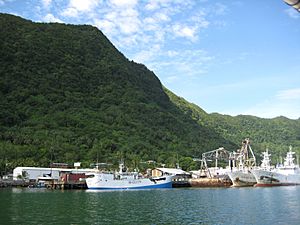
American Samoa's economy is similar to other U.S. territories. It depends on decisions made by the federal government. Tuna canning is the main way American Samoa makes money. In the mid-1960s, American Samoa tried to start a tourism industry. But they stopped because it would cost more money than it would make. Agriculture and fishing still provide food for local families.
Most people in American Samoa work in one of three areas. Each area has about 5,000 workers: the public sector (government jobs), the one remaining tuna cannery (a factory that cans tuna), and other private businesses.
There are a few federal employees in American Samoa. There are also some active duty military personnel. The Pele U.S. Army Reserve Center is in Tafuna. A U.S. Army and United States Marine Corps recruiting station is in Nuʻuuli.
Most public sector employees work for the American Samoa local government. There used to be two tuna canneries: Chicken of the Sea and StarKist. Now, StarKist is the only tuna cannery. It sells hundreds of millions of dollars worth of canned tuna to the United States each year.
In 2007, the Fair Minimum Wage Act of 2007 was passed. This law said that the minimum wage in American Samoa would go up by 50 cents per hour each year. It would keep increasing until it reached the same as the federal minimum wage of $7.25 per hour in the United States. Chicken of the Sea could not stay in business after this law. Starkist started letting go of workers in 2010 because of the minimum wage increases and other costs.
The unemployment rate was 29.8% in 2005. It improved to 23.8% by 2010. In 2017, American Samoa's GDP (Gross Domestic Product, the total value of goods and services produced) was $634 million. Its GDP per person was $11,200 in 2016.
Like in other U.S. territories, some parts of telecommunications in American Samoa are not as good as in the United States. Recent estimates show that American Samoa's Internet speed is slower than some countries in Eastern Europe.
Fun Facts About American Samoa
- The National Park of American Samoa gets about 5,000 visitors each year.
- The most fast-food restaurants are found on the American Samoa island of Tutuila.
- About three-fourths of American Samoans are considered obese (very overweight).
- American Samoans are 56 times more likely to play in the NFL than men from the United States.
- About 80% of American Samoans work at tuna canneries.
- Canned tuna makes up 93% of what American Samoa exports (sells to other countries).
- Sea turtles are called "l'asa," which means "sacred fish." People say they helped lost fishermen by swimming with them to shore.
- There are so many different kinds of fish in American Samoa. If you swam around the reefs once a week, you could see a new fish species each time for eighteen years!
- A coral that is over fifteen feet tall and thought to be hundreds of years old lives off the coast of Taʻu island.
- The flying fox is one of only three mammal species in American Samoa.
- Research shows that it rains an average of 300 days a year in American Samoa.
- It is a tradition to bury a child's afterbirth (placenta) near the family home. This connects the child to the community.
Images for kids
-
Tuimanuʻa Elisala Alalamua, the last official titleholder of Tui Manuʻa (1899–1909)
-
Rear Admiral Benjamin Franklin Tilley, the first Governor of American Samoa (1900–1901)
-
Death of Fleuriot de Langle in 1787
-
English author W. Somerset Maugham stayed at Sadie Thompson Inn during his six-week visit to Pago Pago in 1916.
-
Cockscomb Point on Pola Island is seen jutting into the ocean.
-
A view of American Samoa's Ofu Beach on Ofu Island in the Manuʻa Islands
-
Jean P. Haydon Museum in Pago Pago
-
American Samoa at the South Pacific Games
-
The Samoa flying fox is only found in Fiji and the Samoan Islands.
-
The Blue-crowned lorikeet is the only parrot found in American Samoa.
See also
 In Spanish: Samoa Americana para niños
In Spanish: Samoa Americana para niños




